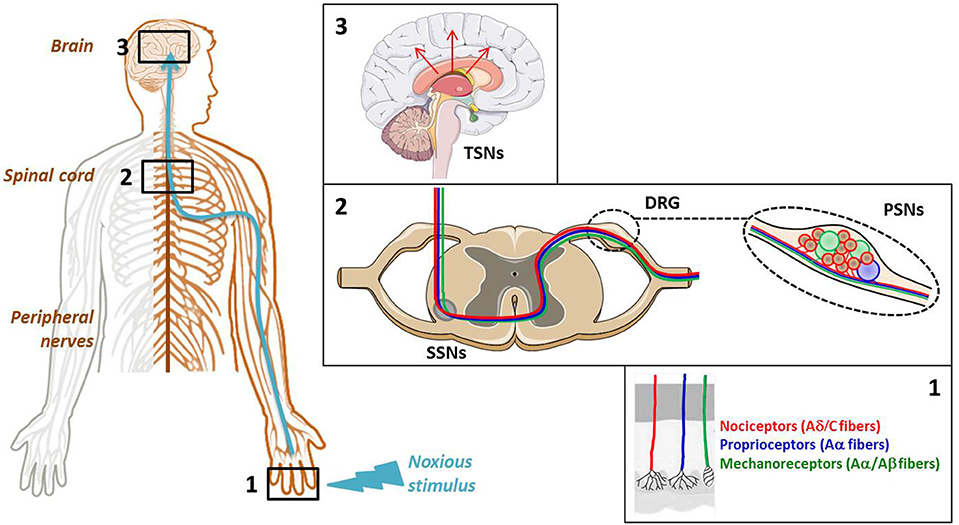
95% of researchers rate our articles as excellent or good
Learn more about the work of our research integrity team to safeguard the quality of each article we publish.
Find out more
CORRECTION article
Front. Pharmacol. , 24 October 2018
Sec. Pharmacology of Ion Channels and Channelopathies
Volume 9 - 2018 | https://doi.org/10.3389/fphar.2018.01241
This article is part of the Research Topic Animal Toxins as Comprehensive Pharmacological Tools to Identify Diverse Ion Channels View all 7 articles
This article is a correction to:
The NaV1.7 Channel Subtype as an Antinociceptive Target for Spider Toxins in Adult Dorsal Root Ganglia Neurons
A Corrigendum on
The NaV1.7 Channel Subtype as an Antinociceptive Target for Spider Toxins in Adult Dorsal Root Ganglia Neurons
by Gonçalves, T. C., Benoit, E., Partiseti, M., and Servent, D. (2018) Front. Pharmacol. 9:1000. doi: 10.3389/fphar.2018.01000
In the original article, there was a mistake in Figure 1 as published. Nociceptors (C-fibers) and Proprioceptors (Aδ-fibers) instead of Nociceptors (Aδ/C fibers) and Proprioceptors (Aα fibers). The corrected Figure 1 appears below. The authors apologize for this error and state that this does not change the scientific conclusions of the article in any way. The original article has been updated.

Figure 1. Cellular elements involved in pain transmission from the peripheral to the central nervous system (CNS). (Box 1) The pain (thermal, high pressure, mechanical, chemical) information is first detected by the receptors located at the level of free nerve endings of primary sensory neuron (PSN) fibers. (Box 2) Then, it is conveyed by the dendrites of these neurons, components of dorsal root ganglia (DRG), to the dorsal horn of spinal cord where it is transmitted to the dendrites of secondary sensory neurons (SSNs). (Box 3) Finally, it is brought to the hypothalamus via the tertiary sensory neurons (TSNs) whose cell bodies constitute, in part, the brain cortex.
TG and MP are current or former employees of Sanofi.
The remaining authors declare that the research was conducted in the absence of any commercial or financial relationships that could be construed as a potential conflict of interest.
Keywords: voltage-gated sodium channels, NaV1.7 channel subtype, spider toxins, pain, dorsal root ganglia neurons, electrophysiology
Citation: Gonçalves TC, Benoit E, Partiseti M and Servent D (2018) Corrigendum: The NaV1.7 Channel Subtype as an Antinociceptive Target for Spider Toxins in Adult Dorsal Root Ganglia Neurons. Front. Pharmacol. 9:1241. doi: 10.3389/fphar.2018.01241
Received: 05 October 2018; Accepted: 12 October 2018;
Published: 24 October 2018.
Edited and reviewed by: Yuri N. Utkin, Institute of Bioorganic Chemistry (RAS), Russia
Copyright © 2018 Gonçalves, Benoit, Partiseti and Servent. This is an open-access article distributed under the terms of the Creative Commons Attribution License (CC BY). The use, distribution or reproduction in other forums is permitted, provided the original author(s) and the copyright owner(s) are credited and that the original publication in this journal is cited, in accordance with accepted academic practice. No use, distribution or reproduction is permitted which does not comply with these terms.
*Correspondence: Denis Servent, ZGVuaXMuc2VydmVudEBjZWEuZnI=
Disclaimer: All claims expressed in this article are solely those of the authors and do not necessarily represent those of their affiliated organizations, or those of the publisher, the editors and the reviewers. Any product that may be evaluated in this article or claim that may be made by its manufacturer is not guaranteed or endorsed by the publisher.
Research integrity at Frontiers

Learn more about the work of our research integrity team to safeguard the quality of each article we publish.